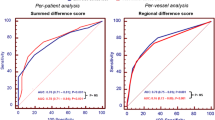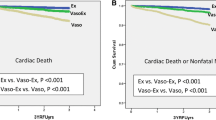Abstract
The conventional dobutamine (Dob) stress protocol for myocardial perfusion scintigraphy (MPS) is long, with frequent adverse effects, and generally requires atropine injection to reach target heart rate. Atropine is usually administered at the end of the protocol, when adverse effects are more frequent. Earlier atropine injection may be useful to shorten the stress protocol and reduce adverse effects. We sought to compare a Dob stress protocol with early atropine injection to a conventional Dob stress protocol in the same patients undergoing MPS. 30 patients underwent Dob-MPS with a conventional protocol (steps of 10, 20, 30 and 40 mcg/kg/min at 3 min intervals, adding atropine to the maximal Dob dose if necessary to achieve 85% of the age-corrected maximal predicted heart rate) and with an accelerated protocol with early atropine injection (at the end of the first stage). We compared stress duration, maximal heart rate (HR), percentage of maximal predicted HR, rate-pressure product, ST changes, MPS scores and the incidence of adverse effects between the 2 protocols. The accelerated protocol was shorter than the conventional protocol (7.1 ± 3.4 min vs. 11.8 ± 1.3 min; P < 0.0001), had the same efficacy to achieve hemodynamic parameters, without increasing adverse effects. The summed stress scores obtained by automatic analysis were similar in both protocols (6.3 ± 6.3 vs. 6.8 ± 6.3; P = NS) as well as the summed difference scores (2.5 ± 3.6 vs. 2.7 ± 3.4; P = NS). Early atropine injection during dobutamine stress protocol shortens stress duration. Our results suggest that patient safety and accuracy of MPS are unaltered, when compared to the conventional protocol, but further, larger studies are still necessary.


Similar content being viewed by others
References
Geleijnse ML, Elhendy A, Fioretti PM, Roelandt JR (2000) Dobutamine stress myocardial perfusion imaging. J Am Coll Cardiol 36(7):2017–2027
Gibbons RJ, Abrams J, Chatterjee K et al (2003) ACC/AHA 2002 guideline update for the management of patients with chronic stable angina–summary article: a report of the American college of cardiology/American heart association task force on practice guidelines (committee on the management of patients with chronic stable Angina). J Am Coll Cardiol 41(1):159–168
Hays JT, Mahmarian JJ, Cochran AJ, Verani MS (1993) Dobutamine thallium-201 tomography for evaluating patients with suspected coronary artery disease unable to undergo exercise or vasodilator pharmacologic stress testing. J Am Coll Cardiol 21(7):1583–1590
Leao Lima Rde S, De Lorenzo A, Issa A (2008) Reduced adverse effects with an accelerated dobutamine stress protocol compared with the conventional protocol: a prospective, randomized myocardial perfusion scintigraphy study. Int J Cardiovasc Imaging 24(1):55–59
Cerqueira MD, Weissman NJ, Dilsizian V et al (2002) Standardized myocardial segmentation and nomenclature for tomographic imaging of the heart. A statement for healthcare professionals from the cardiac imaging committee of the council on clinical cardiology of the American heart association. Int J Cardiovasc Imaging 18(1):539–542
Hansen CL, Goldstein RA, Akinboboye OO et al (2007) Myocardial perfusion and function: single photon emission computed tomography. J Nucl Cardiol 14(6):e39–e60
Camarozano AC, Siqueira-Filho AG, Weitzel LH et al (2006) The effects of early administration of atropine during dobutamine stress echocardiography: advantages and disadvantages of early dobutamine-atropine protocol. Cardiovasc Ultrasound 4(1):17
Tsutsui JM, Osorio AF, Lario FA et al (2004) Comparison of safety and efficacy of the early injection of atropine during dobutamine stress echocardiography with the conventional protocol. Am J Cardiol 94(11):1367–1372
Calnon DA, Glover DK, Beller GA et al (1997) Effects of dobutamine stress on myocardial blood flow, 99mTc sestamibi uptake, and systolic wall thickening in the presence of coronary artery stenoses: implications for dobutamine stress testing. Circulation 96(7):2353–2360
Conflict of interest
None.
Author information
Authors and Affiliations
Corresponding author
Rights and permissions
About this article
Cite this article
Issa, A., De Lorenzo, A., Oliveira, B. et al. Comparison between accelerated and conventional dobutamine stress protocols for myocardial perfusion scintigraphy. Int J Cardiovasc Imaging 28, 1823–1828 (2012). https://doi.org/10.1007/s10554-011-0002-4
Received:
Accepted:
Published:
Issue Date:
DOI: https://doi.org/10.1007/s10554-011-0002-4




